As homeowners, there are many jobs and repairs that require the use of ladders. When working from heights it’s important to be able to recognize the hazards and know how to protect yourself. In this article, we’d like to share with you some fall protection basics that you can use to help protect yourself from serious injuries, or even death! For some basic ladder safety tips please read our blog article on ladder safety. In many cases, those safety tips may be all that’s required for most of your smaller projects. However, there are some projects and jobs around the house that can put you at serious risk! For those jobs, you need to include fall protection too.
As I mention in the ladder safety article, thousands of people are injured from falls each year. A few hundred even die from their injuries. Fall protection equipment can protect you from some of these serious injuries or death if used properly. There are literally hundreds of different options when it comes to fall protection equipment. Some of it can be expensive. I want to focus on the basic equipment that is more affordable and therefore something the average homeowner would be more likely to buy and use.
When Do You Need Fall Protection
Table of Contents
Anytime you work from a ladder you put yourself at some level of risk, based on the height you are working and the potential hazards in the surrounding area under you. By using basic ladder safety technics you can help reduce those risks. But, the higher you go and depending on the task you’re doing, can significantly elevate the risks.
In the ladder safety and fall protection training I’ve had we’ve always been taught that at a height of as little as 4 feet, you need to consider fall protection. Some minor tasks like changing a light bulb may not require it. If you can complete the task with one hand and it only involves a very short amount of time, you’re probably okay. If the job is more complex and requires you to use both hands, you should definitely consider fall protection.
What Are The Fall Protection Basic Components?
In its most basic form, it is made up of three components. The harness, an anchor point, and a lanyard. Each component has specific requirements and they need to be used properly. Fall protection systems are designed to keep forces on the human body to a safe level (at or below 1800 pounds of force). Let’s look at each item, some of their requirements, and how they are used together. I’ve included links throughout the article that will provide more information on these items and their pricing.
The Harness
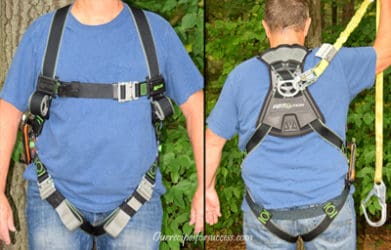
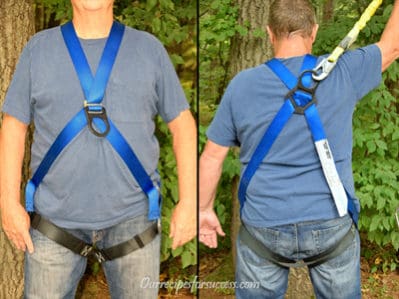
A full body harness is a requirement today for fall protection. They have straps that attach around the legs and also the waist/chest area. The harness should be adjusted to fit the user snugly, yet still, allow ease of movement. On most models, the “D” ring, where the lanyard attaches, is in the middle of the upper back. The blue harness in the picture is one a tower might use. It is a basic model and has a “D” ring in the front too, but it should only be used for positioning while working.
In the past, a waist belt was often used, but they can cause serious back and internal injuries themselves and are no longer allowed by OSHA (Occupational Safety & Health Administration) for fall protection. If you still have one in the back of your closet, I’d leave it there or throw it away.
Lanyard
The lanyard is the connections between the harness and the anchor point. There are several different types of lanyards, but we will focus on the two basic types.
Restraint Lanyard

A restraint is just what it sounds like; a length of rope or a strap that limits how far you can move. Their purpose is to keep you away from a dangerous edge. Like the edge of a roof. They are also used to keep you physically inside of a man-lift basket or to “position” you to work from a ladder when at a dangerous height. The term “position” means to strictly limit how far you can move from a given location. For that reason, most restraint type lanyards are 6 feet or less in length. In most positioning application the shorter the restraint the better. I will cover the hazards of the improper use of a restraint below.
Fall Arresting Lanyard
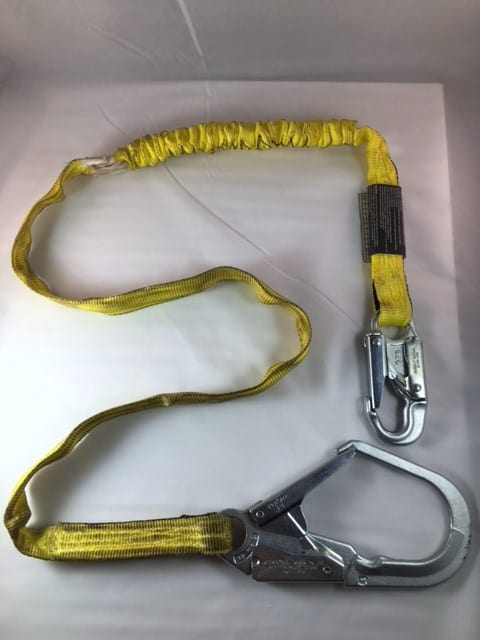
A fall arresting lanyard is typically made of a nylon strap with a means to catch you and quickly slow your rate of fall to a level that won’t cause serious injury. This is normally done by having a tear-away system built into the lanyard. Even though the fall will be limited in speed it will increase the fall distance, so this needs to be considered when selecting the lanyard length and your anchor point!
Anchor Point
The anchor point is what you will be connecting your fall protection equipment too. Selecting the correct anchor point is extremely important. Let’s look at anchor point requirements you need to consider.
Strength
According to OSHA, the anchor point needs to be able to able to support 5000 pounds. I know what you’re thinking, 5000 pounds is crazy and it may be a little excessive in many cases. But don’t forget OSHA is setting a standard that covers everyone and there are a lot of forces at play. Forces like how much you weigh, how much does the equipment/gear you’re wearing weights, and how far you could fall. For example, one of the training guides I have, by USA Burgess, shows that a 225-pound person falling 6 feet, with restraint type lanyard, can generate 4000 pounds of force on the anchor!
The takeaway here is you can’t connect to a rain gutter or a PVC sewer vent on your roof. You’ll need to use something like a chimney or a very well installed antenna or satellite dish bracket. Another option is to run a rope up and over the house and anchor it to a fence or some other structure. When making these types of connections be sure to look for any rough or sharp edges that could damage the anchor line. If you have areas of concern you can use old pieces of carpet or throw rugs to put between your anchor line and those rough spots.
Height/Location
The location of your anchor point, in relation to where you are working, is very important. The best case is it needs to be high as you can get it and it should be directly over you. Let’s take a look at why this is so important.
You need it as high as possible to limit the distance you could potentially fall. This is particularly important if you are using a restraint and not a fall arresting lanyard. If you’re using a 6’ restraint lanyard and it’s anchored near your feet, your body will be subjected to the bulk of the 4000 pounds of force mentioned earlier! That’s not a good thing!
As mentioned, for maximum benefit the anchor point should be directly over you. If it is off to one side, this will create a pendulum effect and could cause you to swing into adjacent objects. The greater the angle, the greater potential for injury. Another potential issue is if the lanyard comes into contact with some sort of edge during the fall. The swinging action can damage the restraint/lanyard causing it to break.
So when picking your anchor point make sure it’s sturdy, directly over your work area, and as high as possible. This will give you the greatest protection.
Basic Fall Protection Accessories
There are many fall protection accessories that can be added depending on the situation. I found a few that could work well for home projects or if you work at height frequently.
Rope Lines/Rope Grab
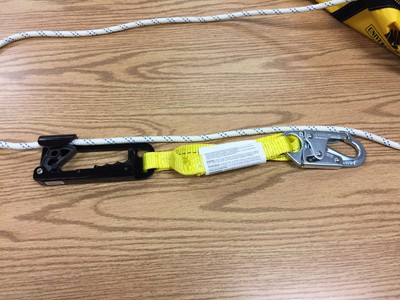
Rope grab systems are great for situations where you might be climbing up and down repeatedly or having to position yourself at different heights. They are great for things like roofing installation/repairs, painting, and window washing. Remember if the rope is anchored around something with rough edges or extends over the edge of the roof it must be protected to prevent damage.
Window/door Anchor
Another unique accessory is the portable window/door anchor. These work great for using dormer windows as an anchor point for gutter cleaning, but can also be used on any window for painting and window cleaning or repair.
Suspension Trauma Straps
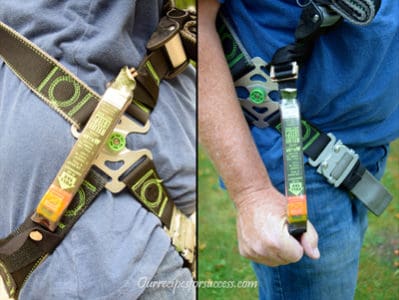
The condition “suspension trauma” occurs when you hang in a harness for a prolonged period of time. Suspension trauma straps attach to the sides of your harness and allow you to stand, which relieves the strap pressure on your legs. These devices are very important! I will provide more information on them below.
Fall From Height Injuries
This is the part of the article that describes how you can potentially be killed in a fall from heights. The good news is you have the ability to reduce these serious types of injuries. Learning to recognize the hazards and adding fall protection equipment to your list of PPE is a great first step. Combine this with ladder safety you and you can reduce your risk immensely! Let’s look at what you can save yourself from.
Fall protection systems are designed to limit the forces to the body to 1800 lbs or less. There are several factors that contribute to fall-related injuries. Things like the age and health of the individual, the fall distance, the fall protection equipment used, and whether or not the equipment was being used properly. The actual injuries from falls come in a few different ways. To fully understand the importance of using fall protection correctly we need to look at a few of the potential injuries from falls.
No Fall Protection
The most obvious injuries come from not using any fall protection at all. Even a short distant fall of 4’ to 6’ can cause bruising, sprains, and broken bones. Just the natural act of trying to land on your feet or trying to catch yourself can cause injuries to the feet, legs, wrists, and arms. Falls from greater heights often results in more serious injuries to the hips/pelvis, internal injuries, and concussions/head injuries. These injuries can easily lead to death.
Improper Use Of Fall Protection
If harnesses are modified or worn to lose, workers have been known to receive cuts, abrasions, bruising, and in worse case scenarios, internal injuries from straps riding up. In some cases, workers have actually slipped out of their harnesses, which leads to the same injuries as not wearing a harness at all.
Selecting the wrong lanyard/restraint can be another deadly mistake. Remember if you are using a restraint, keep it as short as possible and keep the anchor point as high as possible. If you fall 6 feet with a restraint, remember from earlier, the anchor point can be subjected to 4000 pounds of force. Fall harnesses are designed to spread forces over the entire body, but if non-shock absorbing lanyards/restraints are used improperly, falls of greater than 6 feet can lead to serious internal injuries. These injuries can cause death too!
If you cannot limit the potential fall distance to less than six feet, due to the anchor point location, than you must use a fall arresting lanyard. Remember you must allow for the extra length of the fall arrest lanyard when it’s fully deployed. Usually, it’s recommended to add at least two foot of extra clearance, beyond the length of a fully deployed lanyard, to make sure you do not hit the ground.
Suspension Trauma
What is suspension trauma? What causes it? Why is it dangerous? How do you treat it? How do you prevent it? If you do not know the answers to these questions, please take the time to learn them. Suspension trauma is the most unsuspecting killer of the bunch! When someone is involved in a fall event and is suspended, you need to note the time. The “danger clock” has just started ticking!
What Is Suspension Trauma?
So you’ve just fallen and your fall protection equipment has done its job and saved you from serious injury. Guess what… you’re not safe yet! You need to get down as soon as possible. This is when you become at risk for the effects of suspension trauma. It’s a condition where the blood pools in the legs of fall victims while they are suspended in a harness for an extended period of time. Suspension trauma is known by a few different names. It is sometimes referred to as “orthostatic shock while suspended” or “harness hang syndrome” (HHS) too.
In our circulatory system, the blood is moved throughout the body by the heart. We all know that. But did you know that actually, the heart is not strong enough to pump the blood up out of the legs by itself? In fact, the normal contractions of our leg muscles actually assist the heart by forcing/pumping blood up out of our legs. Wikipedia has a great description of this “skeletal-muscle pump” mechanism our body has. Once we lose the benefit of this pumping mechanism, we are at a greater risk for suspension trauma.
What Causes Suspension Trauma?
The problem arises when the human body becomes immobile in the vertical position. When a victim is knocked unconscious during the fall, the danger clock begins immediately. Other victims can become tired and fatigued by repeated attempts to free themselves or improve their situation. Age and physical fitness can play a role too.
With the victim hanging immobile in the vertical position, the blood will begin to pool in the legs. Again this is mainly caused by the harness straps restricting the blood flow out of the legs, the loss of the skeletal-muscle pump action in the legs, and an elevated heart rate, which is typical for a fall situation, forcing blood into the legs.
What Are The Symptoms Of Suspension Trauma?
People who are suffering from suspension trauma can experience any or all of the symptoms below. It’s important to remember that symptoms can begin in as little as 10 minutes. It depends on the person’s age, health, other injuries sustained in the fall, and how “active” they’ve been in trying to self-rescue themselves. Here are a few of the typical symptoms.
- Dizziness or lightheaded
- Having trouble catching your breath
- Heavy sweating
- The skin begins to turn pale
- Hot flashes
- Nausea
- Blurred vision
- Numbness in the arms and legs
Why is Suspension Trauma dangerous?
There are a couple of dangers related to suspension trauma. The first is the danger you face while hanging in the harness. Once rescued from a prolonged suspension event, the secondary threat comes into play.
Danger During The Suspension
Due to a large amount of blood pooled in the legs, I’ve read that the body can start to show signs of going into shock within 10 minutes after a fall. Things only get worse from there. The body will increase the heart rate to help keep the blood supplied to the brain and other organs. This also forces more blood to the legs. Victims show signs of becoming nauseous, dizzy, and they will eventually faint. Within 20-30 minutes a victim can become unconscious and die while hanging in a harness!
Danger After The Suspension
If someone is involved in a fall/suspension event, and have been rescued, they are not out of the woods yet! The pooled blood in the legs has the tendency to become “toxic” from the normal cell oxygen/waste exchange. If the pooled blood is allowed to freely leave the legs and return to the torso, it can overwhelm the heart and the bodies ability to handle/filter the blood. This is called “reflow syndrome”. This in-rush of toxic blood can lead to heart failure!
How Do You Treat Suspension Trauma?
First of all, I need to let you know I am not a doctor. The treatment items below are for first responders and consist of basic first aid treatments. I was taught these items during “basic fall protection” and “fall rescue” training courses. If someone is showing any of the signs or symptoms of suspension trauma listed above, you need to call 911 and get them medical attention fast! Until medical help arrives there are some things you can do to help.
- ABC’s of life come first. Airway. Breathing. Compressions. If the victim is unconscious, not breathing and has no pulse, begin CPR and rescue breathing immediately.
- If the victim is conscious, do not lay them down flat! Instead leave them in a sitting position, with their back up against a wall or tree. Have them bring their knees up to their chest. They should stay this way for at least 30-40 minutes. This will allow the blood to slowly be released from the legs.
- Do not loosen the leg straps on the victim’s harness. This will aid in the slow release of blood from the legs as well.
- Monitor the victim’s pulse and breathing until EMS arrives. Only lay the victim down to begin CPR, if needed.
- When EMS arrives be sure to let them know you suspect suspension trauma. EMS will determine when it is safe to move the victim.
How do you prevent suspension trauma?
When working at heights there are a few things you can do to help protect yourself against suspension trauma. Below are a few easy, practical items you can use to limit the risk. Let’s take a look.
- Have a helper – When working with ladders, especially at higher elevations, you should always have a helper. These helpers will be your first line of defense should you fall and need help. Even if it’s something as simple as standing your ladder back up, so you can get your feet on the rungs. And worst case scenario is they will be there to call 911 and get other help. Something as simple as holding a 2 x 4 up, so the victim can put a foot on it to help relieve the strap pressure on the legs can make a huge difference.
- Rescue Plan – Before you ever do any elevated work you should plan for the worst-case scenario. The company I work for requires us to have a rescue plan and a second person on-site before any elevated work begins. Make sure your helper understand their role in the plan and that they stay with you at all times. Your plan can be as simple as calling 911, getting someone nearby to help, or setting up a ladder to help get you down.
- Fall Protection Equipment – Wearing properly adjusted fall protection equipment is a must. I highly recommend the use of suspension trauma straps. They alone can increase the time you can hang in a harness before the symptoms of a suspension trauma begin. That additional time could give emergency responders time to get to you and get you down.
Whether you’re doing a project at work or at home, understanding fall protection basics is very important when working at heights. Knowing what the basic fall protection components and requirements are is a great first step. Actually using the fall protection equipment is what will protect you and significantly lower the risk of injury or death. Also raising awareness of suspension trauma was another one of our main goals for writing this article. Hopefully, you will share this information with your friends and family.
If you have any comments or questions, you can leave them in the comments section below or you can email us at [email protected]. FYI, we do not collect or share email addresses. We will only use them to reply to your comments or provide answers to your questions. We are also required to let you know that some of our links are “affiliate links”. This means if you click on a link and make a purchase, we could make a small commission, at no extra cost to you. This helps offset the cost of maintaining our website. So, if you like what you’ve seen, please be sure to give us a “Like” and “Share” on Facebook and Instagram too. Thank you for reading and good luck with all your home projects!

I totally agree! I worked in an industrial setting for nearly 38 years and the training and equipment use requirements grew every year. Fall injury/death statists showed great improvement in the industrial environment however, home incidents showed little change. The goal of this article was to help bring awareness to some of the potential hazards when working at heights.
Your blog clearly gives ideas about all sorts of fall protection that is needed. Along with these the workers should be well-trained and make available the equipment when at work. Individuals can also use protective vests as they protect from fire, chemicals and other hazardous substances. Thus the industrial rope access Sydney offers full security for people so they can batte out the risks associated.